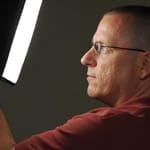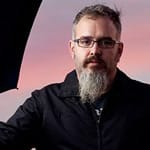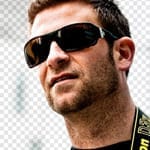
Being inspired is a crucial part of being creative. The more things you feed your brain with, the more chance a great idea will bubble to the surface. I try to take inspiration from many sources but in this first instalment of what will probably become a sporadic series, I want to share with you a few photographers that never fail to give me an inspirational and motivational shove in the right direction.
 David Hobby (aka The Strobist)
David Hobby (aka The Strobist)
If you are into photography or lighting enough to be reading my blog, you are bound to have heard of The Strobist. David is the man who brought about the huge off-camera flash renaissance and drove the price of old Nikon flashes through the roof on eBay If you’ve not read it yet get the hell out of here and go read Strobist 101. I’ll wait! It was reading that series of posts and seeing just what you can do with small flashes that really sparked my interest in lighting. He’s since released two DVDs. The first is a solid intro to off-camera flash with some great live demonstrations while the second really shows how David has finessed his style and will take you even deeper. His current project is HoCo360 – a visual journal of his home county.
Twitter | G+ | Blog | Portfolio
 Zack Arias
Zack Arias
Zack is based in Atlanta and describes himself as an editorial and commercial photographer but he is also a great educator. Between them, David and Zack got me interested in working with lights and taught me more than I’ll ever be able to thank them for. Zack’s OneLight DVD is out of production unfortunately but his “shutter speed controls ambient, aperture control flash” mantra really made the penny drop for me. Not only is Zack incredibly good at explaining complex concepts, he has a practical, down to earth, no BS attitude that I have taken a lot from. His honesty and openness is refreshing in a “fake it til you make it” world. Zack also as a huge Tumblr site which is dedicated to nothing but Q&A. This is solid gold! There is everything from advice on lighting and composition to business and marketing tips. To give an idea of scale, Zack has answered well over a 1000 questions, but only 100 of them were needed to fill the The Photography Q&A Book
Twitter | FB | G+| Blog | Portfolio
 Chase Jarvis
Chase Jarvis
Chase epitomises frankness. He’s been blowing open the doors of the photography world for years, or as he puts it, he was “transparent long before it was hip to be so”. So long in fact that the old guard accused him of ruining the industry by giving away all their secrets! It’s Chase’s “rising tide floats all boats” ideaology that inspired me to start sharing what I have learnt with the world.
He even stages what can only be described as his own monthly live chat show on which he sits down with a variety of inspiring creative people. Add a few past episode to your YouTube watch later list, you can’t fail to be motivated. Chase is also the co-founder of CreativeLIVE, an incredible training resource with a unique business model that lets you watch every course, live, as it’s being filmed for free. Being able to ask some of the names in this list questions via Twitter and get a live response for free is well… priceless!
On top of everything he gives back to the community, Chase is an amazing photographer, a hugely likeable chap and walking proof that being different, not just incrementally better gets you places.
Twitter | FB | G+ | Blog | Portfolio

Chase Jarvis posted on his blog last week asking his readers to finish a sentence: “My pictures would be better if…”. So I did. I thought about it carefully and put my reply out into the world amongst the huge stream of comments.
My pictures would be better if I got myself out of my comfort zone more often, took more risks and had a better idea of where to aim my passion/energy/hustle.
So now it’s out there, maybe I should clarify.
I stay in my comfort zone by only working with models I know when I could be arranging things on Model Mayhem and Purestorm for more variety in my portfolio.
Taking more risks would allow me to go after jobs and arrange shoots that the nagging voice in head tells me I am not ready for. There are lots of great venues I’d love to shoot in (bars, hotels etc) so I need to pop into these places and talk to the boss. I’ve done it once and that resulted in a shoot in a cinema in a couple of weeks so why don’t I do it more? Could I shoot a family portrait session or even a wedding? I have come a long way but I know I can go a lot further.
The big one is knowing where to focus my energy. I get myself super motivated, I produce solid work and I’m ready to work my face off – but I don’t know where to direct all that enthusiasm. I can’t progress if I don’t know what direction to set off in. Although it feels safe to hide behind the fact I’ve not sat down and thought about it yet, it’s much easier to steer a moving ship so it’s time to get sailing. There’s no point in having lots of business and marketing ideas if I don’t hang out my shingle so I need to work on a business plan and find out if there is a market for what I want to do. I’m talking about walking away from my day job on a whim but I do want to be able to spend more time doing what I love rather than what I must. Isn’t it better to try and fail than not try at all?
Hence the image at the top: my Big Book of Hustle. This is where the ideas go. There is where I write down the hard questions, and with any luck, some answers too. Time to man up!
Am I alone in this or do others have a heap of motivation and energy but no target to aim it all at? Am I the only one who has a clear picture of the end goal but has yet to work out what achievable steps to take to move towards it? Hit the comments below if you have the same problem or any solutions.

After watching a couple of Chase Jarvis videos lately about his studios approach to data storage and backup, I thought I’d wade in and give you my smaller scale version. I might not work on assignments the size of Chase’s (yet!) but loosing my images, even if it’s just my personal projects with no paying client, is still not something I want to experience.

I don’t understand the logic in spending money on the latest camera body and quality glass, then risking every single image to save £20 by buying a cheap and nasty CF card. Even with the 5DMkII’s 25MB RAW files I don’t go above 16GB. 500 shots on one card is enough for me, and I don’t keep shooting until they are completely full so there’s always a quiet moment to swap. Once out of the camera, they go to different places – first into my Black Rapid strap pocket, second into my camera bag etc.

After the shoot I get the data from the cards as soon as possible. This is will either be to my MacBook Pro or main iMac depending on where I am. I use Lightroom to copy the data to the on board hard disk and a 2nd external drive at once. In the case of the laptop it’s a 500GB USB driver, with the iMac it’s to my Drobo. I also leave the data on the cards until I need to reuse them – no point in deleting another backup unless you have to. If the data was uploaded to my laptop, it gets imported into the main library on my iMac and Drobo as soon as I get back to base.
So at the is stage I can lose my iMac hard drive and one of the drives in my Drobo and still have a backup. I’ve also still got the original Lightroom catalogue on my laptop and the corresponding backup – although that won’t have any of the adjustments I have made on my main studio computer.

The final chink in my backup armour here is the location of the drives; pretty much side by side. So if the building suffers a power surge, fire, flood or zombie attack I could be in trouble. Enter another couple of bare 500GB drives containing another copy of the data that rotate out to an off-site location after every shoot. No disused cold war bunker or safety deposit vault here – just a different building far enough away not to be caught up in the same natural disaster.
Not quite on the same scale as CJ Inc. but still similar principles at work.
- Use quality cards and drives
- Make a backup of the data on your cards a soon after shooting as you can
- Don’t erase those cards until you have to
- Always keep your data on more than one drive and;
- Ideally keep those drives in more than one place.

 David Hobby (aka The Strobist)
David Hobby (aka The Strobist)








Recent Comments